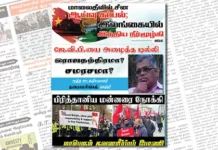Sri Lanka’s apparel workers, mostly female, provide an important contribution to the country’s economy. In 2019, apparel exports amounted to $5.2 billion, almost 40% of all exports. The industry provides direct employment to 300,000 people and indirect employment to 600,000. Around 350 garment factories are operating in different parts of the country, while there are around 16 textile and fabric manufacturing units.
However, after the Covid-19 pandemic, exports declined sharply as lockdowns hit production and order cancellations were high. The pandemic exposed the darker side of the industry, with workers complaining about being subject to inhuman conditions both inside and outside the factories, bringing into question the country’s hard won reputation as an ethical source of apparel and doubts whether it lives up to the slogan, Garments Without Guilt.
In her book, Garments without Guilt? Global Labour Justice and Ethical Codes in Sri Lankan Apparels, Kanchana N. Ruwanpura, Professor of Human Geography at the University of Gothenburg, explores two main topics – what institutional factors facilitated Sri Lankan apparels to evade the negative publicity unlike neighbouring countries in South Asian and how ethical trading, the codes that underpin global governance regimes formative for global supply chains, factors into the process and where are the voices of workers?
Conducted over a period of 10 years, Dr. Ruwanpura delved deep into the lives of apparel workers, spending time watching them work, visiting their homes and attending their celebrations. She answers questions from Groundviews about her research findings.
What are the areas in which the Sri Lanka apparel industry has succeeded and where has it failed?
Sri Lankan garments does great things in many ways. Its ability to do this also rests upon the fact that there is a strong legislative basis and high social and human development indices within Sri Lanka. It is important not to lose sight of these foundational facets. The industry itself too has made great strides; its attention to the built environment in many ways is unparallel in South Asia and Sri Lankan apparels big players have gone from being local capital to global capital. So Sri Lankan apparels is successful business in so far as capital accumulation goes. Along with capitals success, taking a temporal view, as I try to do in my book, I also wanted to focus on workers and their role in the achievements of Sri Lankan garments. I do this both by looking at the collective agency of workers (various labour struggles and their mobilizations at distinct points) as well as how workers make their mark within the factory floor; worker agency continuously matter, as most managers are likely to recognise even if not all may acknowledge it. So, Sri Lankan apparels success is in every sense a capital-management-labour story, sometimes in consort with each other and at other times oppositional. This dynamic means that Sri Lankan apparels, from the viewpoint of labour, does very well in several areas. Work conditions within factories are usually safe and hygienic, child labour is scarce, regular employment is provided and often workers choose to work, although this is mitigated by the fact that work in the formal sector is limited. Yet, there are sore points: lack of a living wage and the inability to freely associate and collectively bargain (unionize). These two facets are the underbelly of Sri Lankan garments. The paucity of living wages also has an effect on over time. Workers try to secure a larger wage packet through over time work, being more productive and trying to be regularly present at work. This means that during production cycles and the high season, work hours can be long and production floors can be tense and stressful for both workers and production floor supervisors and managers alike. This is the downside. I would argue that these weaknesses are fundamentally linked to the absence of a living wage. Here Sri Lankan garments can do better. Sri Lankan garments need to look at their salary distribution from corporate owners to managers to workers and reconsider how workers ought to be paid a living wage, not through overtime and incentives alone. It will certainly also go some way towards alleviating Sri Lanka’s growing and relative income inequality.
Are workers more aware of their rights now?
I accessed workers by being based at two factories and through these initial groups reaching out to others. If I am to trace patterns on worker awareness, I would say that their consciousness of rights is varied. Often, I found that it was the older workers, those that have toiled in the industry for well over a decade or more that had cognizance of their rights. Often men, irrespective of their age, were also aware of their rights as were the highly educated workers. Younger workers and those that saw their work at factories as a temporary were the least aware or often were preoccupied with being youthful. However, when economic realities dictated that working in the factory was not a short phase, then their awareness of their rights tended deepen. They rightly started from an awareness of their economic poverty propelling them to be familiar with their rights.
Are they more willing to report sexual harassment and discrimination because of their gender despite the stigma?
Harassment and discrimination on the factory floor are not always and necessarily only sexual in nature. It is gendered but not always a case of men supervisors and floor managers harassing and discriminating women. To offer an illustration, in one factory I was based at there were many more women that were at the helm as line supervisors or production floor managers and often working men too had to face harsh treatment. What I often found that workers – men, women and their line workers – were quick to stand their ground if they were harassed or witnessed harassment whether verbally abused or shouted at. There is also the ethnic dimension that we often forget. Sri Lankan apparels is no longer solely reliant on a majority workforce. From about 2009, or just before, Sri Lankan apparels moved to the North and East of the country and the FTZ in the South of the country started to draw on workers from the North, East and plantation areas. If there was an earnest effort towards integration through jobs, then a decade later differences based on language and ethnicity continue to matter. Since I was based at factories well outside of the Free Trade Zone, I couldn’t make the claim that I was witness to sexual harassment as commonly invoked through media on the factory floors. None of the workers shared any evidence to establish constant sexual harassment. This is not to say that it doesn’t exist; simply that I don’t have the evidence to make the argument that it does.
Do employers have a responsibility to look beyond the factory floor and improve housing, transport and health for their workers?
On issues beyond the factory floor, I think, here we need to shift our focus towards the state too. Public health, public transport and even perhaps even social housing should be seriously considered by the state and the successive government. Workers that live adjacent to Free Trade Zones or factories outside of the factories are simply not regulated and so, sometimes, workers share boarding rooms in the multiple or on a rotating basis. For boarding owners, their income – to the best of my knowledge – is not taxed, there are no requirements on the size of rooms or numbers to occupy such rooms; in essence this is an unregulated black economy. This is also tax revenue lost for the government. Tighter regulation and greater provision of public housing, public transport and public health is a must; this will also engender better conditions for labour outside of the factory floor. The culpability on this failure then lies with recurrent governments in the past four decades.
During the start of Covid-19, there were many reports of the bad working conditions of apparel workers. Were these justified?
Covid-19 was a moment in which the flaws within Sri Lankan apparels came to full view. To start with, poor housing conditions of workers, being jammed into shared rooms in private boarding houses revealed itself. Densely populated housing, as is the case adjacent to FTZs or factories, overcrowded and unregulated boarding rooms are all fertile ground for Covid-19 to spread and it spread rapidly amongst working class communities. These poor living conditions of workers is also, however, linked to the absence of living wage. If workers don’t earn a living wage, they will cut corners on the housing they seek, the type of housing and so forth. It is the destitution of the housing stock of workers that mattered when Covid-19 was brought into the factory floor. The outbreak of Covid-19 within factory floor is a reminder that generating superlative factory sites alone is not sufficient to protect the health of workers.
Can the Sri Lankan apparel industry justifiably adopt the slogan Garments Without Guilt (GWG) or has this just been a clever marketing ploy?
I think to argue that GWG and as an ethical sourcing destination as solely a clever marketing ploy would be unjustifiable. Compared to other South Asian countries, Sri Lankan apparels does very well but this is also labour laws and educated workers have helped keep the bar high. So, in certain realms there is certainly a genuine aspiration towards ethicality and efforts to upgrade production sites. And of course, labour voice and their collective strength – past and present – also is an important bulwark.
How did writing this book change you as a person and what lessons did you learn from your research?
Tenacity. I learnt that from my workers; their determination to be treated justly and with dignity. On reflection, it is not so much that my research or writing the book changed me as a person but rather it brought heightened awareness that in many ways we are bound together with how we navigate the struggles that we encounter. And humanity and generosity are also all around us, if we seek to tap into it.
Book details:
https://www.cambridge.org/core/books/garments-without-guilt/FB0306278CC8ED7EBDDEF3ADF9A7B804#





